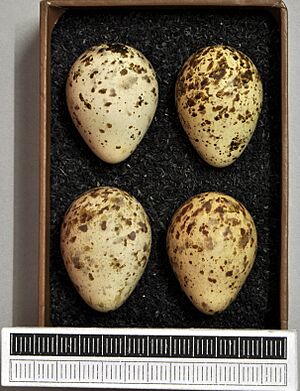Temminck's stint facts for kids
Quick facts for kids Temminck's stint |
|
|---|---|
 |
|
| In breeding plumage | |
| Conservation status | |
| Scientific classification | |
 |
|
| Range of C. temminckii
Breeding Passage Non-breeding |
|
| Synonyms | |
|
Erolia temminckii |
The Temminck's Stint (Calidris temminckii) is a small bird that likes to wade in shallow water. It's named after a Dutch scientist named Coenraad Jacob Temminck. Its scientific name, Calidris, comes from an old Greek word used by Aristotle for grey birds found near water.
This bird is protected by an important agreement called the AEWA, which helps save birds that travel long distances between Africa and Eurasia.
About the Temminck's Stint
These birds are quite small, only about 13.5–15 cm (5.3–5.9 in) long. They look a bit like the little stint, but their legs are shorter, and their wings are longer.
You can spot them by their yellow legs and white outer tail feathers. The little stint has dark legs and grey tail feathers. Their feathers are mostly plain brown on top and on their head. Their underside is white, but their chest is a bit darker. When they are ready to breed, their back feathers get a brighter reddish-brown color. In winter, they look like a tiny version of a common sandpiper.
Their call is a loud, trilling sound.
Life Cycle and Reproduction
This stint breeds in wet, marshy areas and bogs in the cold taiga forests. These areas are found in the Arctic parts of northern Europe and Asia. Sometimes, they even breed in southern Scandinavia and occasionally in Scotland.
When looking for a mate, the male bird performs a special hovering flight. They make a simple nest on the ground, which is just a shallow dip. Here, the female lays 3 to 4 eggs.
Temminck's Stints are birds that travel very far. They spend their winters in warm, freshwater places. These places include tropical Africa, the Indian Subcontinent, and parts of Southeast Asia.
These birds have a unique way of raising their young. Both the male and female parents take care of different sets of eggs. First, the male bird finds a small area and mates with a female. She lays her first clutch of eggs there. Then, she moves to a new area, mates with another male, and lays a second clutch of eggs, which she incubates herself. At the same time, the first male might mate with another female. This new female lays her second clutch of eggs in his territory. The first male then takes care of the first female's first clutch of eggs all by himself.
What They Eat
Temminck's Stints look for food in soft, muddy areas that have some plants. They mostly pick up food they can see. They have a special way of moving, like a mouse, as they creep along the edges of ponds. They mainly eat insects and other tiny creatures without backbones.
They don't usually gather in large groups like other Calidris wading birds.
Gallery
-
In non-breeding plumage at Purbasthali in Bardhaman District of West Bengal, India.
-
In Manohara River, Kathmandu. Nepal.
-
Breeding plumage at Keoladeo National Park, Rajasthan, India.











